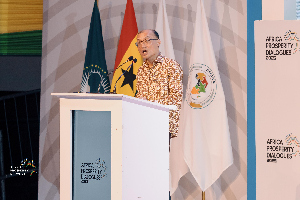THE NEW PARTNERSHIP FOR AFRICA’S DEVELOPMENT1
The latter part of 1950s marked the beginning of the independence movement against colonial rule with the local leaders of these independence movements assuming the helms of government in African countries.
The political forms at this stage were external instigated, designed and funded by the colonial administration who often favoured the Western model of political governance based on multi-party political system. However, no sooner had these locals been installed, than attempts made to change the political form from multi-party to single-party form of governance.
These actions were justified on the grounds that the multi-party system was a luxury African countries could not afford. Other views from Africa suggested that the single-party form was a mechanism for fostering national cohesion among social groups in those countries.
In other circumstances this form of governance was pursued to the point of being arbitrary, for example Banda in Malawi, and Mobutu Seseko Waza Banga in (Democratic Republic of Congo) former Zaire, resulting in the suppression of alternative forms of political expression.
However, the beginning of the 1990s witnessed the ‘winds of change’ sweeping across Africa. These ‘winds of change’ have been the resurgence of multi-party form of governance in Africa. In Zambia, a prohibition of political activities was lifted by the Kaunda government which resulted in Chiluba been elected and subsequently replaced.
In Ghana, J.J Rawlings and his NDC administration lifted a prohibition on party political activities and invited other parties to participate in a general election after ten years in office. He went on to win two elections but theNDC was defeated in 2000 by the New Patriotic Party (NPP) led by John Kuffour.
The story was no different in Malawi and Kenya where elections were held after about thirty-four and twenty years of single-party culture in the two countries. However in the case of Kenya, the incumbent remains in power.
The World Bank and other donor agencies have been the dominant advocates of the view that rigidities inherent in the single-party political form of governance contributed significantly to the political and economic decline in Africa. Multi-party form of governance was proposed as an alternative to Africa’s socio-political instabilities.
The implicit view in this claim is that social-political instability is correlated with the rigidities of the single-party political form, and that the multi-party arrangement was sufficient to reverse this socio-political instability and restore discipline to the political system and thereby the economy.
Two questions emerge from the view above (a) to what extent is the multi-party form of governance superior to the single-party form of governance in guaranteeing socio-political stability (b) is enhanced participation through multi-party politics a necessary condition for reversing economic crises or a criminalised economic system?
This paper will argue that it is the underlying economic crises that result in the socio-political instabilities in most African countries, and therefore political governance alone would not lead to economic development since socio-political instability appears to be a symptom of an underlying economic problem. This paper further argues that no political form, be it multi-party or single party, can survive if its underlying economic levers are either weak or out of control.
It is the opinion of this paper that African countries in economic crises should confront the underlying economic decline as the vehicle for addressing the socio-political instabilities. In other words African countries should seek first the economic kingdom and all others will be added.
The theme of this paper will be discussed under seven sections. Section two will deal with the theoretical perspectives of the claim that enhanced political participation through multi-party politics leads to economic viability and control. This is followed in section three by a review of the debate on the economic crises in Africa outlining the core questions of this discussion. In section four, a number of selected case studies are reviewed from Malawi, Zambia, South Africa, Ghana and Rwanda.
Section five critically analyses the possible relationship between economic crises, political form and socio-political instabilities in Africa.
Section six considers the issues reviewed for the new partnership for Africa's development which for the first time outlines the commitment of African leaders to a partnership between the African population and a strategic collaboration with the international community.
Section seven concludes with some proposals.
SECTION TWO
IntroductionThis section will examine the strengths and weaknesses of three major notions that have been articulated to support multi-party political form as an alternative to single-party politics in Africa.
The Theory of Politics and Markets:
An established notion suggests that there is a link between multi-party politics and markets. Lipset [1959] and Friedman [1962 and 1980] have argued that the relationship between markets and politics are that of mutual reinforcement.
Lindblom [1977] also concluded that politics and market are mutually reinforcing for the following reasons: (a) that polyarchy systems have certain rules for constraining rather than mobilising authority i.e. they protect freedom of contracts and private property, and hence strengthen market systems (b) that both multi-party form and markets practise decentralisation in decision making and diffusion of power and influence.
The limitation of Lindblom’s study is that it is based on a developed country scenario where markets are fully fledged and therefore does not apply to Africa since markets in Africa are either non-existent or rudimentary. Another limitation implicit in the theory that multi-party form of governance and markets mutually reinforce each other, is the untested view that multi-party political form is more market oriented than the single-party political form.
Healey and Robinson [1992] who argued that there has been no empirical work have challenged the theory above, which systematically correlates political form to markets. This source points out that ‘there is no assurance from past experience that either democratic or authoritarian regimes will follow or not follow market oriented policies’.
Whilst Healey and Robinson’s point is relevant they also agree that political forms and markets co-exist but they do not categorically make the case that, a market culture formation and creation is a necessary condition, for this to apply to Africa.
This paper is of the view that any political form or system cannot exist without a strong market culture. The experience in Africa suggest that there is a weak market system, and as a result any political form, multi or single party is likely to experience socio-political instabilities unless repressive tactics are institutionalised as part of that system.
A conscious effort has to be made to create and expand a market. Whether this will be done does not depend on the type of political form that is practised in a country, rather it is the deliberate process of ‘political leadership’, vision, and skills in building a market economy that are important.
Kuznets (1966) emphasises that multi-party politics encourages more representation, which then minimises the tendency for socio-political instability and thereby promotes a conducive environment for market activities. Implicit in his argument is an attempt to systematically correlate political instability to lower economic growth however little evidence exist to suggest that those instabilities are associated to any particular type of political governance.
McGowan and Johnson [1985] have provided an empirical study where they correlate political instability ( in terms of frequent government change, coup d’?tat and military intervention) with economic growth between 1960-84 period in Africa. The evidence showed that political instability inhibited economic growth, because trade and the functioning of markets is disrupted, however a link or association with a corresponding form of political governance is not established.
Another study by Barro [1991] concluded that low economic activities was largely the result of investments diverted away from the countries engulfed by political instabilities.
Although these studies all support the view that political instability exacerbates economic decline, they do not attribute the cause to the underlying economic crises and the absence of a market oriented business community but instead concentrate on political representation with an inherent favour for a multi-party form.
A further notion relates to the legitimacy and efficiency by which African governments respond to economic crises. The view is that an efficient government is one with wide political support and therefore capable of exerting its legitimate control to bring about economic reforms [Diamond, Linz and Lipset, 1988]. The multi-party school of thought argues that competitive political elections offer a safety valve for the legal channelling of disaffection and encourage patience. That they provide opportunities for peaceful change and alternative government with popular support and legitimacy to undertake the austerity measures and reforms necessary for economic reforms. However, developing country evidence suggest that in Asian countries like Taiwan and Korea, regimes that may be described as authoritarian had the capacity to implement efficient and legitimate responses to economic crises [Healey and Robinson, 1992].
Healey and Robinson concluded that when it came to economic policy making ‘whatever the regime type, a key factor was the political leadership, especially in achieving compromise and consensus policy action’.
What seems to count in the formulation of policy is not the rules of domestic political system, but the ideology of leadership, the structure of decision-making, the quality and role played by the bureaucracy, the composition of governing coalitions, the relationship of the government to business and trade unions, and the role of external powers, especial the international development community.
Summary:
From this section it is clear that there is no established correlation between a political form and effectiveness of economic policies that are taken to redress economic crisis. Both multi-party and single -party governments have the capacity to make good or bad decisions. It seems to be the case that it all depends on the leadership. From this perspective, this paper reinforces the argument that a change from one political form to another i.e. single party to multi-party which characterises the recent situation in Africa will not necessarily lead to the resolution of the economic crises being experienced by the African population. The next section will outline the nature of the economic crises in Africa and the main indicators used in their quantification.SECTION THREE
Introduction
This section reviews the debate about the nature of the economic crises in Africa and the kinds of responses necessary for mitigating them. It also outlines the alternative definitions used in this paper to describing political forms and attempts to quantify economic crises and socio-political instability in Africa.Economic Crises in Africa: The Debate:
To understand the recent political reforms in Africa, it is essential to examine the history and the debate underlying the economic crisis and how they link to the political forms in AfricaFrom independence in the late 1950s African economies experienced a steady economic growth of 2.5% [Blomstrom, 1993]. The effects of the rise in oil prices in the early 70s displaced the international economic system and adversely affected African economies.
However by the late 1970s advanced market based economies had recovered from this dislocation of the international economy but most African countries did not recover and instead stagnated [Blomstrom, 1993]. This situation was exacerbated in the beginning of 1980s when the economies of about twenty-nine African countries declined [Blomstrom, 1993].
According to Blomstrom ‘for more than a century from the 1870 to the 1970 African exports grew rapidly and their share of world exports increased. In the 70s export growth in Sub-Saharan Africa petered out; followed by a huge decline in the 80s. Export earnings in current dollars fell from US $50 billion in 1980 to about $ 36 billion at the beginning of the 1990s. The whole of Sub-Saharan Africa, forty five countries with almost 500 million inhabitants, now has export revenues less than half of those of Hong Kong, a nation of six million people’.
These statistics about Africa’s share of market in the global economy clearly show the nature of the economic crisis that Africa has to deal with. For any country to be able to have a vital economic activity it needs to generate income from its export. Dominant opinion mostly by World Bank have tried to analyse the economic crisis by citing the Gross Domestic Product (GDP) instead of the Gross National Product (GNP) as a major indicator of those country’s economic activity.
However the definition of GDP by Bannock, Baxter, and Davies, (1992) that suggest this indicator conceals and overestimates the real income of these economies since it does not take into account the income arising from investments and possessions owned by foreign investors which constitutes a substantial part of the economic activities of those countries. This indicator is therefore contestable since it distorts and implies that African economies are not part of the international economic system.
Furthermore it does not reflect the real life situation per se because for example Ghana which was cited as a success story by the World Bank for demonstrating a high and rising levels GDP simultaneously experienced a decline in quality of life (locally called Rawlings’ Chain) which prompted the Ghana government to introduce a programme called Programme of Action To Mitigate the Social Cost of Adjustment (PAMSCAD).
It is the overall participation of the country in the international economic system, mainly through diversified and large export share, that leads to an increase in economic activity within the country, as a result, the GDP of that country will increase [Blomstrom, 1993]. Clearly, GDP is a quantity depends very much on international economic activity, therefore can not be used as a significant measure of the entire economic activity of a country. In view of the limitations of GDP this paper uses the export income/revenue of African countries in the international economy as the indicator of economic performance.
As to what caused the decline in the economies of most African countries, there are two major schools of thought to explain this phenomenon. One school stresses factors that are external to the individual African country in terms of deteriorating barter terms of trade for primary commodities. The other line of thought emphasises internal factors that is, overvalued exchange rates and high taxes on exports. There are also diverging opinions on how the line of causation runs, that is, whether export failure caused economic stagnation or vice versa.
What is indisputable, however is that the decrease of real export earnings went hand in hand with an overall decline in economic activity in most Sub-Saharan African countries, [Blomstrom, 1993]. The important issue here is how this decline in economic activity due to low export revenue resulted in economic crisis which then coincided with socio-political instability. As will be demonstrated in selected African countries, low export revenue over a certain time period consistently coincides with socio-political instability.
This paper views Africa as part of the international economic system and therefore subject to whatever instabilities that occur in that system. Against this background, the economic crises faced in Africa are seen to be the result of gyrations or so called shocks from International Economic Instabilities (IEI). International Economic Instabilities (IEI) are characterised by certain events that may be described as low and high peaks of selected global events or activities such as the gulf war, ending of cold war hostilities and global oil supply insecurities. For the purpose of this paper three such events will be selected for illustration.
The first IEI was the oil price shock in the 70s and 80s which resulted in the decline of the export revenues of about twenty nine (29) African economies from 2.5 % to (-0.5 %) [Blomstrom, 1993]. The detailed case studies in section four provide information and statistical data on how each of the chosen countries had a decline in export share and economic activity due to this international economic instability (IEI).
The second IEI was the world recession in the 1980s. According to Blomstrom the world recession of the 1980s lead to the decrease in Africa’s export income by 3%. The 80s were labelled as the lost decade in Africa because most of the economies were either in stagnation or in decline. This period also coincided with a massive rescheduling as well as borrowing by African countries in order to survive and thereby compounded the economic crises and unleashed a debt spiral. This was the decade of widespread poverty in sub- Saharan Africa.
The third IEI was the ramifications of the end of the cold war. The end of the cold war created new alliances in the international economic systems, and in the process marginalised African countries since the former Soviet Union States (Eastern Europe) assumed top priority in the allocation of funds and loans. This was because as indicated earlier, the oil price increases and the recession in 1980, made African countries dependent on scarce bilateral and multi-lateral loans for their revenues.
Until the end of the cold war, African countries were able to reschedule and obtain new loans for economic activities mainly from the World Bank and the IMF but the shift in emphasis to the former Soviet Union States following the end of the cold war limited this option. In recent times, African countries would have to accept a highly indebted poor country status in order to benefit from any kind World Bank or IMF facility.
Summary:
KEYIEIs that have contributed to economic crises in Africa are the oil price increases, world recession and the aftermath of the cold war. We have also argued that there is a correlation between IEIs and the economic crises that have and still impact on African countries. The next section will examine the export performance of a selected number of African economies as a basis for a critical analysis of the key issues of this paper.SECTION FOUR
This section briefly outlines the export performance, political reforms and socio-political instabilities in selected African economies. The aim is to provide an empirical basis to the central argument of this paper those economic crises is no respecter of either multi-party or single-party political form.Malawi:
The main export of this country is tobacco. Malawi is included in this study because it is typical of the Anglophile countries which was led by a single political party and one leader since independence and a centre of debt rescheduling. Recently, the government lifted the ban on party political activities and invited other parties to contest in a general election.
Export Revenue (K millions) before 1972
| 1966 | 1969 | 1970 | 1971 | |||
| Exports | 27.6 | 33.2 | 34.0 | 36.0 | 40.0 | 49 |
| Imports | 54 | 50 | 59 | 61 | 71 | 82 |
| Balance | -26.4 | -16.8 | -25.0 | -25.0 | -31.0 | -33.0 |
Export Revenue (K million) after 1972
| | 1984 | 1985 | 1986 | 1987 | 1988 | 1989 |
| Exports | 446 | 433 | 445 | 602 | 750 | 743 |
| Imports | 381 | 486 | 478 | 653 | 1035 | 1398 |
| Balance | +64 | -53 | -32 | -51 | -285 | -655 |
Political Form (PF) before 1972: Single Party - One President
Political From (PF) after 1972: Single Party - One President
Socio-Political Instabilities (SPI) before 1972: A massive rebellion
Socio-Political Instabilities (SPI) after 1972:20000 Malawi refugees, massive internal displacement
Zambia:
Copper accounts for over 90% of the export revenue of this country. It exhibits similar characteristics as Malawi in terms of its Anglophone connections. It is also a recipient of the World Bank debt assistance programme. It was led by Kenneth Kaunda from independence and practiced a single party political form until recently when other parties were invited to participate in a general election resulting in the election of President Chiluba.Export Revenue (K million) before 1972
| | 1967 | 1968 | 1969 | 1970 | 1971 |
| Exports | 470 | 540 | 754 | 710 | 479 |
| Imports | 306.4 | 325.2 | 311.8 | 340.8 | 395.4 |
| Balance | +163.6 | +214.8 | +442.2 | +369.2 | +84.2 |
Export Revenue after 1972:
| | 1981 | 1982 | 1983 | 1984 | 1985 |
| Exports | 921 | 950 | 1052 | 1231 | 2475 |
| Imports | 1093 | 1116 | 1072 | 1329 | 1932 |
| Balance | -172 | -166 | -20 | -98 | 541 |
Political Form before 1972: Single Party - One President
Political Form after 1972: Single Party until 1992, Multi-Party since 1992
Socio-Political Instabilities before 1972: insignificant
Socio-Political Instabilities after 1972: Major trade union strike, coup attempt, riots, and internal displacements
South Africa:
Gold accounts for over 50% of this country’s export revenue. This country is included in this case study for a number of reasons (a) it was Anglophone until it unilaterally declared independence from British administration and became Anglophone and Afrikaans. (b) to support the argument that although the apartheid form of political governance exhibited a multi-party components and was very capable of controlling opposition from all sections like other such regimes in Africa, the political form collapsed under intense international economic sanctions which exacerbated the socio-political instabilities. In 1994 it unbanned all political parties and conducted elections based on one-man-one vote which resulted in the election of President Mandela.Export Revenue (R million) before 1972
| | 1966 | 1967 | 1968 | 1969 | 1970 |
| Export | 1216 | 1323 | 1513 | 1484 | 1413 |
| Imports | 1645 | 1942 | 1885 | 2149 | 2578 |
| Balance | -429 | -619 | -372 | -1270 | -1165 |
Export Revenue [ R million] after 1972 :
| | 1985 | 1986 | 1987 | 1988 | 1989 |
| Exports | 36737 | 41797 | 43202 | 48801 | 58193 |
| Imports | 26894 | 28673 | 39529 | 44742 | 44207 |
| Balance | +11434 | +14903 | +14529 | +9273 | +13986 |


















